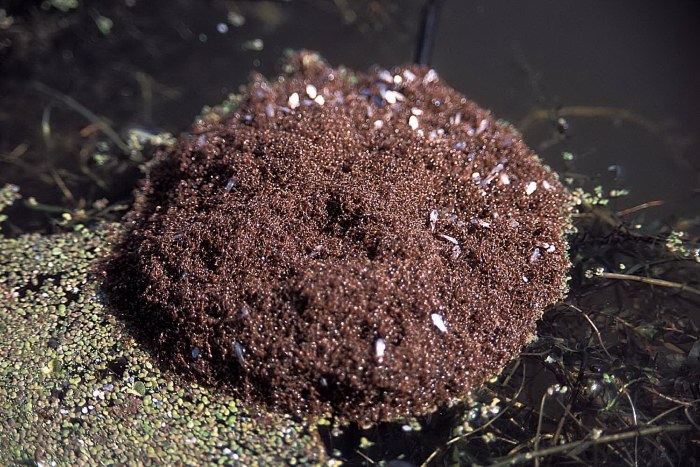Floating-Fire Ants
Seriously, that's why Solenopsis spp. have taken over the Eastern U.S.
ISSG Database wrote:Local dispersal methods
Natural dispersal (local): Natural movement may be in the form of swarming, walking or floating. Movement of this type typically occurs in small increments and takes much longer for a large area to become infested. Walking is simply the movement of an ant colony from one area to another. This may happen due to disturbance or competition in an area (Mississippi State University, 2004).
Water currents: Floating happens when there is flooding in an infested area. Large balls of ants have been observed to float from a flooded area to a dry area (Mississippi State University, 2004).

EDIT: Also, a documentary talked about multiple queens link sub-colonies, a phenomenon heretofore unseen. Talk about consolidation!!!
University of Florida wrote:Multiple Queen Colonies
Early studies of imported fire ant biology indicated that colonies contained single queens (monogyne). However, since 1973, reports have become more frequent of the occurrence of multiple queen (polygyne) colonies. Multiple queen colonies have been found in areas of Florida, Mississippi, Louisiana, Texas, and Georgia, being more frequent in the western edge of their range (Vinson and Sorenson 1986).
Multiple queen colonies differ from single queen colonies in several ways: (1) the mounds are closer together and more numerous per acre of land, (2) the colonies have smaller workers with fewer major workers present, (3) workers are not aggressive towards neighboring colonies, and (4) the queens weigh less and produce fewer eggs than single queens. The overall number of eggs produced in a multiple queen colony is higher than in a single queen colony due to the presence of many queens producing eggs simultaneously. Additionally, fewer reproductive alates of fire ants are produced with the males often being sterile and the females weighing less (Hedges 1998, Vinson and Sorenson 1986).
Also, http://edis.ifas.ufl.edu/in352

Comments